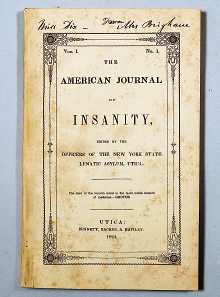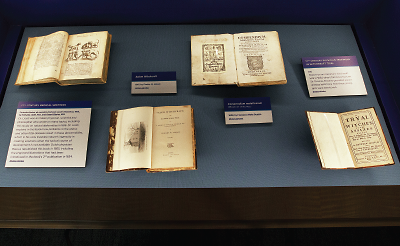In 1487, a discredited priest penned Malleus Maleficarum—usually translated as The Witches’ Hammer—with instructions on how to recognize, hunt, examine, and sentence “witches” by torture and burning. Capturing a wide medieval audience as the authoritative “witch hunters manual,” Malleus Maleficarum would go through 10 editions.
A little over a century after its first printing, a Dutch physician, Johann Weyer, M.D., wrote De Praestigilis Daemonum (On the Illusion of Witches), denouncing Malleus Maleficarum and the use of the text to persecute innocent people—most often women—exhibiting signs of old age and symptoms of mental illness.
Seven centuries later, both of these treasures—a 1584 edition of Malleus Maleficarum and an 1885 French translation of Weyer’s work—reside behind protective glass within the climate-controlled, wood-paneled walls of the Melvin Sabshin, M.D., Library and Archives at APA’s new headquarters in Washington, D.C.
With a collection that includes other archived relics and artifacts—a page from the Gutenberg Bible, admission papers to the 18th century Bedlam Hospital in London—and hundreds of rare books contributed over the years by APA members, the library and archives promises to be a rich trove for researchers and students of the history of psychiatry and the evolving understanding of mental illness.
“We have created a home for our vast collections of rare books and artifacts so that they can be available to our members, researchers, and scholars,” said Daniel Gillison, executive director of the American Psychiatric Association Foundation. “The Foundation is the steward of the history of APA and has taken great care to create an environment to preserve the collection and educate our members on its significance to the profession.
“The history of APA is an important part of the history of psychiatry in this country,” Gillison continued. “By understanding the origins of organized psychiatry, we gain an understanding of the evolution of the observation, care, and treatment of people with mental illness in this country.”
The library was designed for APA by Healy Kohler Design of Washington, D.C., which specializes in creating museum and library spaces. The library offers an inviting venue for members and researchers who just want to browse: dimmed lighting in the display cases and bookshelves, comfortable seating, and a quiet atmosphere create an ambience of respect for history.
Its namesake would be proud. Members and staff who remember Melvin Sabshin, M.D., who served as APA’s medical director from 1974 to 1997, know that he brought a keen grasp of where psychiatry was going—he helped to move psychiatry toward an evidence-based rather than an ideologically driven nosology—but also where it had been. He was a scholar of enormous intellectual depth and breadth with a profound regard for history.
“Mel would be so pleased and proud of the library today,” said past APA President and former APA deputy medical director Steven Sharfstein, M.D.
Sharfstein and past APA President Lawrence Hartmann, M.D., co-chaired the advisory committee that worked with the Foundation on developing the library and archives. “The library is a remarkable place for visitors to APA to learn about the history of psychiatry and APA’s contributions to American medicine,” Sharfstein said.
Hartmann said the advisory committee will continue to help expand the library’s collection. An important project is digitization of the library’s collection. Some material is already viewable on iPads in the Members Lounge and the library.
Hartmann and Sharfstein have also supported the Foundation’s Adopt-a-Book program. Donors who contribute between $200 and $5,000 will be recognized on the Foundation website and in association-wide publications while also given some “ownership” in APA’s library. Gillison said the tax-deductible donations will help support the digitization of the collection and the education of members and scholars about the history and significance of the collection.
The library and archives at APA headquarters is something of a renaissance. The library had its origins in 1949 when then Medical Director Daniel Blain, M.D., asked members who had written books to sign and send them to APA. Within a year, APA had received 115 books, which were kept on shelves in Blain’s office. Eventually the total would reach over 1,000.
In 1961, the library—by then housed at APA’s headquarters at 1811 R Street, N.W., in Washington, D.C.—greatly expanded its collection as it acquired important first editions, such as those by Eugen Bleuler, M.D., Sigmund Freud, M.D., and Carl Jung M.D. In 1982, APA moved again—this time to 1400 K Street, N.W., which included a large library and reading room. But when APA moved to Arlington, Va., in 2002, many of the library’s contents were put in storage. For APA CEO and Medical Director Saul Levin, M.D., M.P.A., including space for a library was a major priority in the design of the new headquarters.
“I know how many members deeply care about the history of APA and psychiatry and about the collection of rare books and artifacts that APA has gathered over many years,” he said. “I warmly invite members to come to our new headquarters home and visit the Melvin Sabshin, M.D., Library and Archives.” ■
More information about the library and Adopt-a-Book Program can be accessed
here.



